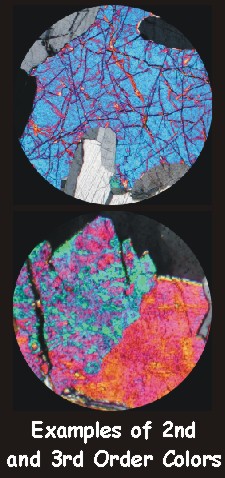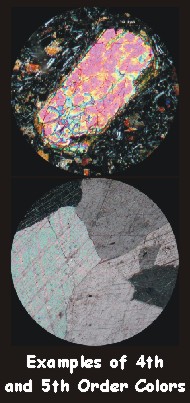Interference Colors:
The Diagnostic Tool
![]()
|
Interference Colors |
||
| For retardations equal to zero no light passes through the analyzer so in crossed-polarized light the image would appear black. |
|
|
| Materials that do not vary in their RI with different directions are called ISOTROPIC. All isotropic minerals appear black under crossed-polars, regardless of the orientation of the stage. | ||
| For low retardations (less than 4,000 Angstroms) no visible light is either completely passed nor completely blocked. The result is grey or white light. |
|
|
| When retardation reaches approximately 4,000 Angstroms then the low end of the visible spectrum (violet-blue) is blocked and so the resulting light shifts to yellow and then red. Low interference colors from grey to pale red are called first-order colors. | ||
| For moderate retardation of 5,500 to 11,000 Angstroms whole colors are either blocked or passed completely. The result is a series of strong colors in the sequence of the spectrum (violet, blue, green, yellow, orange, red) with increasing retardation. These intense colors resulting from moderate retardation are called second-order colors and third-order colors. |  |
|
| For high retardation (>11,000 Angstroms) the resultant interference colors become paler. These high (fourth-order and higher) colors tend to pastel or pearly pinks and greens. |  |
|
| The sequence of possible interference colors with increasing retardation is presented below: | ||
|
|
||
![]()
|
How to Determine Interference Color on a Polarized Light Microscope |
|
|
|
Set up the microscope for cross polarized light (Analyzer In, Gypsum Plate Out) with any immersion medium |
| Scan the field of view while rotating the stage in order to find the particular grains of the mineral of interest that exhibit the maximum interference color based on the chart above. | |
| If the sample is a grain mount (i.e., loose grains set in a immersion oil) like most samples for asbestos analysis, then you must be more particular in your scan: You must find a the maximum interference colors displays by grains of MODERATE THICKNESS. | |
| Determine if the interference colors are black (isotropic), low (first order), moderate (second order) or high (third order). | |
|
How would you describe the interference colors of the minerals in the example in the rollover below? |
|
To see how your description compares to the instructor's...
![]()